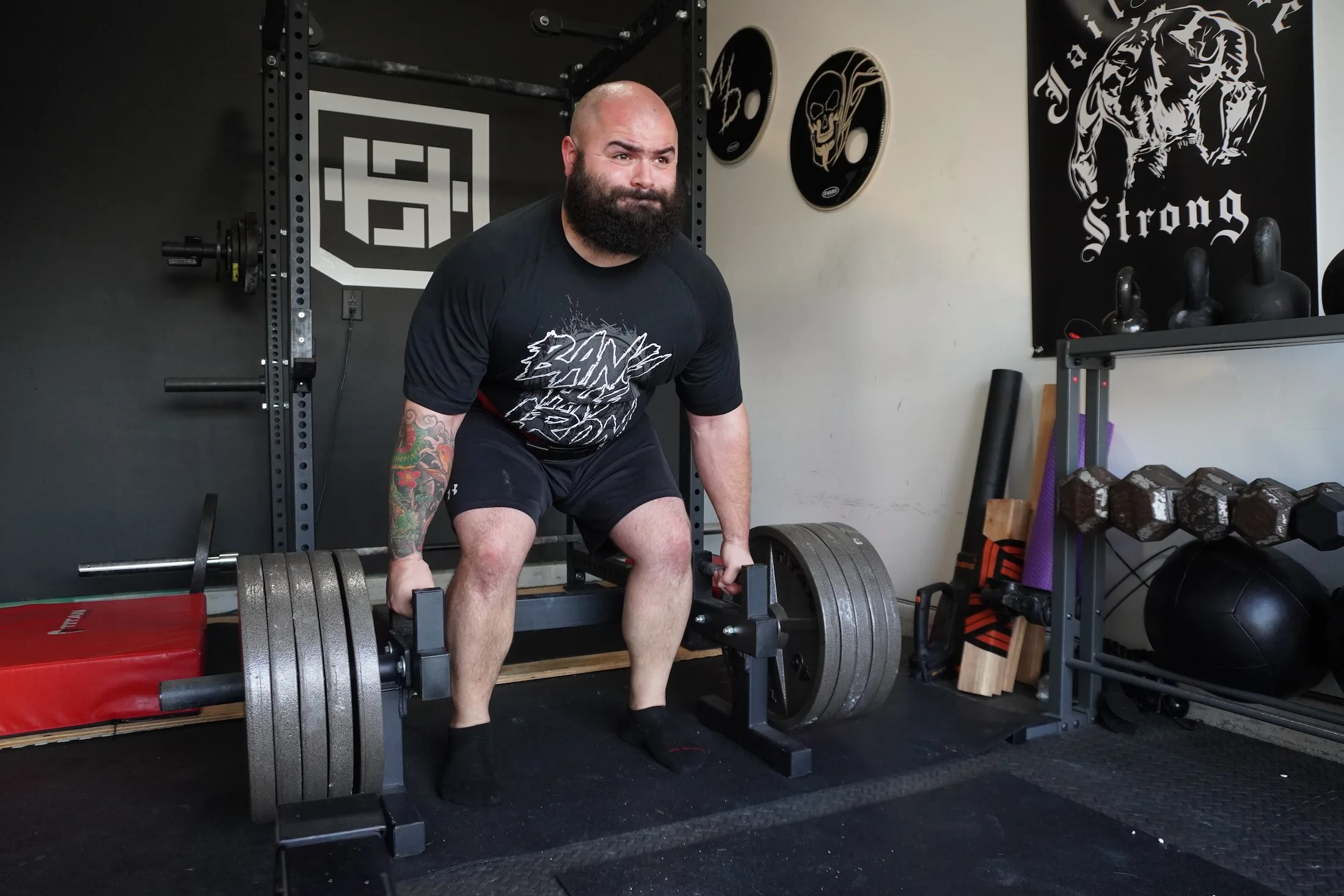Winter Warfare: How to Bulk Up This Season
TOPIC: Strength & Conditioning
It’s that time of the year to wreak havoc and prepare for a massive winter bulk! But wait, what is a winter bulk? What does it take, and how do we achieve it?
Joseph Lucero (CSCS), owner of Harvesting Strength, is a powerlifter and strongman coach with years of practical S&C experience in high school, collegiate, and professional settings. His programs have produced several PL and strongman championships. In this article, he talks about the winter bulk, what it is, and all the top tips for building a dominant presence that will overwhelm the dinner table discussion this holiday season. Check out his sample workout at the end of this article!

Written By
joseph lucero
Joseph Lucero CSCS, owner of Harvesting Strength, is a powerlifter and strongman coach with years of practical S&C experience in high school, collegiate, and professional settings. His athletes have brought home powerlifting medals, strongman championships, and major bragging rights.
Insta
Programs
Website
What’s a Winter Bulk?
A “winter bulk” typically refers to a time of the year when athletes, especially those involved in strength training, aim to increase muscle mass during the winter months. This concept is rooted in the idea that cold winter weather contributes to a better bulk.
During the winter months, we begin to embrace the holiday season with many holiday traditions. Many holiday traditions involve two things — excess calories and a surplus of rest. When you merge these two concepts, you create an anabolic opportunity that lifters dream of!
This opportunity for growth is proven scientifically as well. A study by Harvard University found a 0.5% increase in body weight 10 days after Christmas. This proves the holiday season to be the right time for you to leverage growth for a better bulk.
But why would someone want to perform a winter bulk? Well, with the conditions above proving to be true, this is a time of the year when you’re in a caloric surplus allowing you to lift with more intensity and build a bigger physique. A bigger physique isn’t a bad thing either. The more muscle tissue you grow, the better your metabolism becomes and hormone regulation stays on track.
With that being said, it would be foolish to pass up this opportunity! Why not give yourself a priceless gift this holiday season — the gift of better health and a massive physique?
So while you’re sipping your eggnog and baking treats to get on Santa’s nice list, grab your notebook and prepare to take some notes!
How to Do A Winter Bulk
The recipe for a successful winter bulk consists of extra calories, rest, and a ton of lifting. Getting calories and rest is the easy part! During the winter, don’t completely limit yourself from all the enjoyable foods that come with holiday traditions. I’m not saying you need to eat everything in sight! I’m saying that if you do plan to indulge in some tasty treats, strategically use those additional calories to fuel your next workout session.
When it comes to calories, especially those from carbohydrates, it’s proven to have a positive effect on bouts of heavy resistance training. This study about carbs shows that when a lifter prioritizes carbohydrate consumption, they perform better with their resistance training. In the presence of carbohydrates, a lifter can take on a tough workout that could be the catalyst for muscular growth and development.
This is one of the big reasons why it’s important to embrace a bulk during the winter months. Taking on excessive calories, in particular carbohydrates, is a key determinant of resistance exercise and intensity. Think about it like this:
The harder we can train, the more we can grow.
But to build dense muscle, it’s not always about lifting heavy weights. If you want to build the most size, you need to lift heavy, and lift hard. What’s the difference between the two?
Lift Heavy
Lifting heavy means performing high-intensity compound movements that take immediate priority in your program. These types of movements consist of the squat, bench, deadlift, and overhead press. The benefit of lifting heavy compound movements is the amount of muscular recruitment within each exercise. The more muscle groups incorporated, the more metabolically exhausting your routine becomes.
The level of exhaustion in your routine is what helps build more muscle. It’s been countlessly documented in research that exhausting the muscle tissue is the spark needed to naturally raise testosterone and growth hormone levels for increasing muscular density. You can also train towards exhaustion with isolation exercises.
Using compound movements incorporates multiple joints and multiple muscle groups to help you feel tired quickly. This is what you want, though. Exhaust the body, then move into isolation exercises to focus development within certain muscle groups.
Lift Hard
After you lift heavy weight, you need to start making exercises harder using different tempos, variations, and volumes for exhaustion. Lifting heavy puts metabolic stress on the body, but you can’t maintain this intensity from the start of the workout to the end. Once you have completed your first few compound exercises, it’s important to use isolation movements (and some compound movements sparingly) and integrate different tempos, variations, and volumes to create stronger contractions on specific muscle groups you want to grow.
One of my favorite ways to make lifts harder is to use isolation exercises that require more “time under tension”. This time under tension puts a ton of stress on the working muscle by working it for a prolonged amount of time. An example of this would be doing chest flies for a specific tempo, such as “5-2-3-0”. These 4 values have to do with the 4 phases of movement:
- 5-second stretch of the chest
- 2-second pause at the bottom of the chest
- 3-second contraction to the top of the chest
- 0-second hold at the top of the chest
Manipulating the tempo of movement makes an exercise harder. Because the tempo makes the lift so hard, you might not need to lift as much weight. This is a great way to make sure you continue to exhaust the muscle without using too heavy of weight.

How to Train Both Hard & Heavy for Anabolic Success
When it comes to lifting heavy or lifting hard, neither is best. Merging both heavy and hard lifting is best for providing a better stimulus for growth. When considering these two concepts, try the following format:
- Heavy Compound Movement: 2-3 sets (primary focus is “strength”)
- Heavy Compound Variation: 3-5 sets (primary focus is “exhaustion”)
- Isolation Exercise: 3 sets
- Isolation Exercise: 3 sets
- Isolation Exercise: 3 sets
Starting with a heavy compound exercise recruits multiple muscle groups for a better level of exhaustion. The first compound lift should be with a focus on raw strength, then the second compound movement should be done with more volume to exhaust the anatomy. Then, isolating the muscle groups you want to grow the most afterward will help you target the exact area of the body you want to be the focus of your training session.
Benefits of a Winter Bulk
The benefits of a winter bulk are increasing your resting metabolic rate, improving strength, and providing hormone regulation for more normalcy within the holiday season. You learned earlier that the winter weather causes individuals to naturally gain weight.
Why not leverage this weight gain into something that can be beneficial? Why not use these additional holiday calories to add mass instead? Doing a bulking phase during the colder season makes a lot of sense.
Increased Metabolic Rate
One study found that increases in muscle mass contribute to an increase in resting metabolic rate. With a higher resting metabolism, you can expend more calories at rest. This could be helpful for those who are fearful of unhealthy weight gain during the winter season.
Improved Strength
One of my favorite quotes comes from a previous coach of mine. He told me “mass moves mass”, meaning that the more muscle you pack on, the more likely your strength increases. There could be some exceptions to this. However, I like my odds to bench press more if my body weight goes up. Who wouldn’t want a better bench!
Hormone Regulation
One study found that winter weight gain causes testosterone levels to decrease and estrogen levels to increase. Resistance training helps stabilize your hormones. This is a huge benefit for not just athletes, but anyone! Everyone should embrace their fitness this holiday season, especially resistance training.
Top Tips for a Winter Bulk
When working on your winter bulk, keep these top tips in mind!
Prioritize Compound Movements
Putting an emphasis on compound movements is crucial for a successful winter bulk. Compound movements are also termed “multi-joint” movements, meaning there are two or more joints being used. You are probably familiar with the main compound movements of the squat, bench, deadlift and overhead press. These tend to be popular movements in many programs, and rightfully so.
Compound movements provide an overloading stimulus — the more joints used, the more muscles used. The more muscle we can recruit, the more exhausting your effort becomes. Providing an exhaustive stimulus to the working muscle is the catalyst for growth. This is why compound movements need to take priority, especially at the beginning of your winter bulk workouts.
Embrace Carbohydrates (Within Reason)
Carbohydrates are the number one source of fuel for high intensity resistance training. Interestingly enough, carbohydrates tend to be the most accessible macronutrient in the holiday season. Take advantage of those holiday treats!
This study showed that restrictions of carbohydrates could cause a reduction in performance. Make sure you’re hitting your macronutrient goals, and perhaps exceeding them. Try not to go too far over for multiple days in a row. Work with a nutrition coach to get accurate macro numbers.
Lift More Often
During a winter bulk, you should aim to lift at least 3-5 times a week. I understand that is a big range of days, but those 3-5 days of lifting could be approached differently.
- If you are a busy person who can’t go to the gym often, perhaps you go 3 days a week but those sessions last longer.
- If you are someone who can go to the gym most days, perhaps you go 4-5 days a week but for shorter sessions.
Either way, you need to prioritize your strength training. Watch out for too much high intensity cardiovascular training, that could put you in a caloric deficit that would impact your bulking phase.
For those who want to continue cardiovascular training during a bulk, I would recommend low intensity cardiovascular training that is within 60-65% of their max heart rate.
How do you find your max HR? Generally:
- 220 – Age = Max Heart Rate
So this means if you are 30 years old, your max heart rate is 190 beats per minute, and 60-65% of this heart rate is 114-123 beats per minute. Anything higher than this would put your workout at an intensity that expends precious calories you could use for adding mass. This long, low intensity training prioritizes fat as a source of fuel. We want to spare all those extra carbohydrates for your heavy resistance training.
Hit Failure More Often
You need to hit failure in training to promote growth. Failure doesn’t need to happen in all aspects of your training, though. For compound movements, you want to work towards max effort by the third to fourth week of training. With your isolation movements, this is where you can hit failure more often and try to exhaust your muscle groups.
No one wants to be a failure this holiday season! However, being a failure in your workout is ideal. Fail in reps this holiday season, stud. But don’t fail and buy your spouse the wrong gift. Been there, done that!
Prioritize Rest
Rest is one of the most crucial parts to any training program. If you do not rest, you do not allow the body to repair itself from all the physical torment you put yourself through. During the holiday season, resting should be easier than ever. As noted in this study, due to the limited amount of sunlight, you’re more likely to rest more during the winter season.
This is the perfect condition, yet again, to embrace a bulk during the winter season.
A Sample Winter Bulking Plan
The following is a 4-day split to use this winter season to make gains and have a successful bulk! These workouts follow the guidelines discussed earlier with merging compound movements, isolation movements, and other characteristics of a successful bulking workout. Don’t forget to eat!
Day 1
For this leg workout, we are prioritizing the glutes, hamstrings and quadriceps to build some massive lower body muscles.
| Exercise | Sets | x | Reps | Notes |
| Squats | 2 | x | 6 | Use 76% of your one rep max |
| Walking DB Lunges | 5 | x | 12 Total | 12 total reps |
| Eccentric Barbell RDLs | 3 | x | 8 | Go down slow each rep for 5 seconds |
| Seated Leg Curls | 2 | x | 20 | |
| Leg Extensions | 3 | x | 20,30,30 |
Day 2
This upper body workout focuses on the pecs, triceps, and front shoulders for sculpting a thicker upper body. Nothing is more intense than big bodacious pecs that spark conversation at the dinner table!
| Exercise | Sets | x | Reps | Notes |
| Bench Press | 2 | x | 6 | Use 76% of your one rep max |
| 30 Incline DB Bench Press | 5 | x | 12 | |
| Eccentric Dips | 3 | x | 6 | Go down slow each rep for 5 seconds |
| Cable Tricep Pushdowns | 3 | x | 15 | Use any attachment |
| Machine Chest Flies | 3 | x | 20,30,30 | Use a machine to keep the movement simple for so many reps |
Day 3
This pull day will challenge your back, rear shoulders and glutes as well. We use the farmer walks to amplify the intensity of this workout to prepare you for all the bags you’ll carry with your winter shopping!
| Exercise | Sets | x | Reps | Notes |
| Deadlifts | 2 | x | 6 | Use 76% of your one rep max |
| DB or Trap Bar Farmer Walks | 3 | x | 40 ft | Use a dumbbell or trap bar and walk 40 feet |
| Cable Lat Pulldowns | 3 | x | 12 | Use your bench press grip or a bit more narrow |
| Hammer Grip Row Machine | 5 | x | 20 | |
| Barbell Shrugs | 3 | x | 15 |
Day 4
This secondary press day will challenge your shoulders and biceps, giving you an armor of muscle to protect you from the shoulder-to-shoulder traffic you’ll experience while shopping.
| Exercise | Sets | x | Reps | Notes |
| Standing Barbell Overhead Press | 2 | x | 6 | Use 76% of your one rep max |
| Cable Upright Rows | 5 | x | 12 | Use a straight bar for this movement |
| DB Hammer Curls | 2 | x | 10 | |
| Eccentric Chin Ups | 3 | x | AMP | Do as many reps as you can until you can’t do anymore |
| DB Spider Curls + Cable Face Pulls (SUPERSET) | 5 | x | 20 | Do these exercises back to back with NO rest until each superset is complete |
Final Thoughts
A winter bulk offers a strategic opportunity for strength training enthusiasts to optimize muscle growth. The holiday season’s excess calories and opportunities for rest create an ideal environment for a better bulk, supported by scientific evidence. If you’re scared of the winter bulk, you need to consider the multiple benefits that come with it.
Performing a winter bulk allows for an improved resting metabolic rate, increased strength, and valuable hormone regulation. A winter bulk also gives you a reason to embrace the additional calories this holiday season. So, this winter, give yourself the gift of massive strength and a more robust physique.
Sources
Effects of Carbohydrate Restriction on Strength Performance
The Effect of Carbohydrate Supplementation on Multiple Sessions and Bouts of Resistance Exercise
Holiday weight gain is a worldwide phenomenon, study suggests
Find Your Perfect Training Plan
Sometimes all you need to reach your destination on your fitness journey is an expert guide. Look no further, we've got you covered. Browse from thousands of programs for any goal and every type of athlete.
Try any programming subscription FREE for 7 days!
Related Articles
You May Also Like...
The Ultimate Guide to Lunges: Queen of all Glute Exercises
Your glutes are the largest muscle group in your body. They’re responsible for almost everything your legs do—walking, running, jumping, squatting, lunging, and just standing upright. As far as moving through space goes, strong glutes are the bedrock of overall...
A Beginner’s Guide to Steel Mace Training
Think you’ve mastered kettlebells? Meet the steel mace — the brutal, offset weapon that forces your body into three-dimensional stability, grip work, and rotational strength. Ancient tool. Modern performance.Written Byjesse grund Jesse Grund’s passion is simple: coach...
The Best Bench Press Warm Up Strategy
We get it. You’re pressed for time in the gym. But skipping the warm up is the surest way to underperform and risk injury. This 3D approach to your bench press warm up not only allows you to lift more weight, but also ensures the long-term health of your shoulder...
The Ultimate Guide to Lunges: Queen of all Glute Exercises
Your glutes are the largest muscle group in your body. They’re responsible for almost everything your legs do—walking, running, jumping, squatting, lunging, and just standing upright. As far as moving through space goes, strong glutes are the bedrock of overall...
A Beginner’s Guide to Steel Mace Training
Author: Jesse Grund
Mace training will make you a better mover without it’s not confining you to a fixed space or predetermined range of motion. Second, it’s an offset load with 80 to 90 percent of the weight in the head. You’re also constantly having to resist rotation, which creates greater core engagement.

Want more training content?
Subscribe
For Coaches
For Athletes
About
Support
Training Lab
Access the latest articles, reviews, and case studies from the top strength and conditioning minds in the TH Training Lab!
Made with love, sweat, protein isolate and hard work in Denver, CO
© 2024 TrainHeroic, Inc. All rights reserved.





